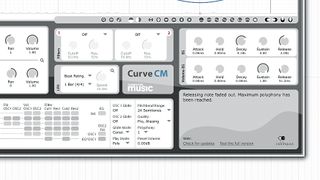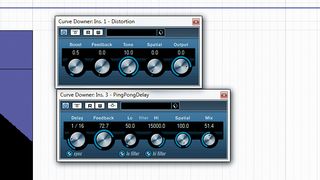How to produce a basic synth downer
Slow the pace of your music with this basic synth tip
Last week we showed you how to produce basic synth risers - pitch rising effects designed to add tension. Here we're looking at downers which are, unsurprisingly, the exact opposite: synth lines that fall in pitch to create a drop in pace ideal for leading in to breakdowns.
In the video above and the step-by-step below we'll show you how to create a basic riser.

Step 1: Downers are the opposite of risers - they're often found at the beginning of breakdowns to help drop the sense of pace. For ours, we want a stereo synth with two oscillators set to sine waves. We fire up Cableguys CurveCM (part of the CM Studio - free with each issue of Computer Music. A demo version of Curve can be downloaded at the Cableguys official site), click the Blank preset button and Pan one oscillator left and the other right before drawing a nice, long C6 note.

Step 2: We're going to use pitchbend to create the downwards shape, so set the synth's Pitchbend Range to +/-24 semitones, and in your MIDI editor, draw in a downwards pitchbend curve. Experimenting with start/end points, curve shapes and note lengths produces endless possibilities, so play around with these parameters before moving onto the next step.

Step 3: Although we've panned our two oscillators, it still sounds mono because they are both generating the exact same sound. That's not a problem - all we have to do is detune the oscillators apart from another. The more extreme the detuning, the more pronounced the stereo effect will be, so don't be shy about trying out large values. We detune Osc 1 to -100 cents and Osc 2 to +100 cents.

Step 4: From here, we can experiment with other effects for texture. Reverb and delays work well for a spacious, floating feeling, while distortion is useful for generating harmonics that pure sine oscillators lack. We add a slight boost with Cubase's Distortion effect to make ours more upfront in the mix before adding a touch of room reverb and a ping-pong delay with Delay time of 1/16.
Get the MusicRadar Newsletter
Want all the hottest music and gear news, reviews, deals, features and more, direct to your inbox? Sign up here.
Computer Music magazine is the world’s best selling publication dedicated solely to making great music with your Mac or PC computer. Each issue it brings its lucky readers the best in cutting-edge tutorials, need-to-know, expert software reviews and even all the tools you actually need to make great music today, courtesy of our legendary CM Plugin Suite.

"If I wasn't recording albums every month, multiple albums, and I wasn't playing on everyone's songs, I wouldn't need any of this”: Travis Barker reveals his production tricks and gear in a new studio tour

“My management and agent have always tried to cover my back on the road”: Neil Young just axed premium gig tickets following advice from The Cure’s Robert Smith











